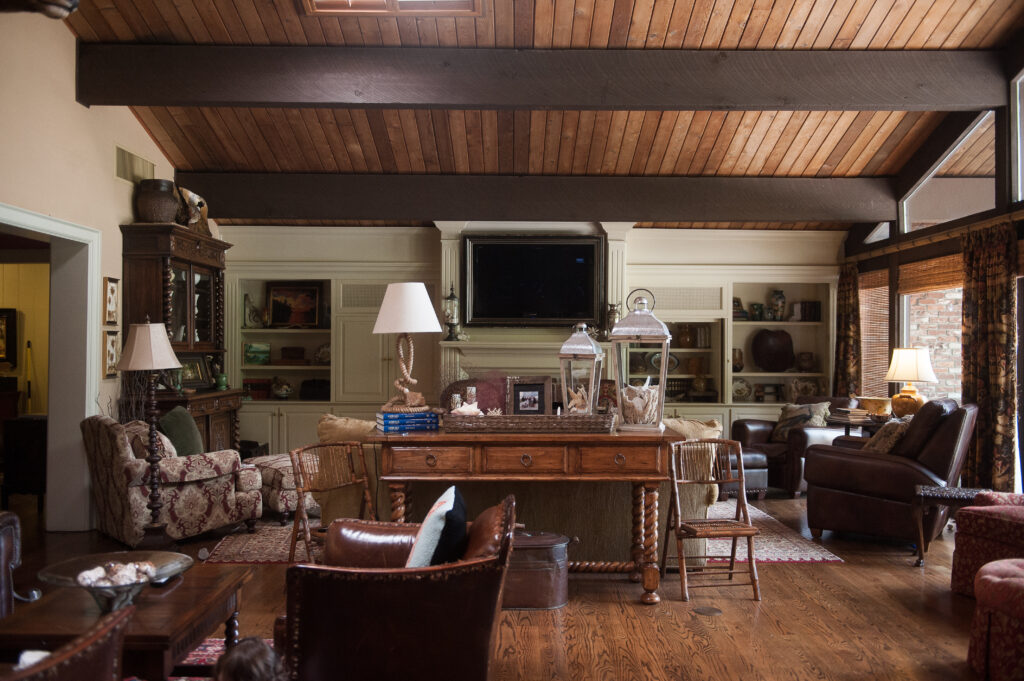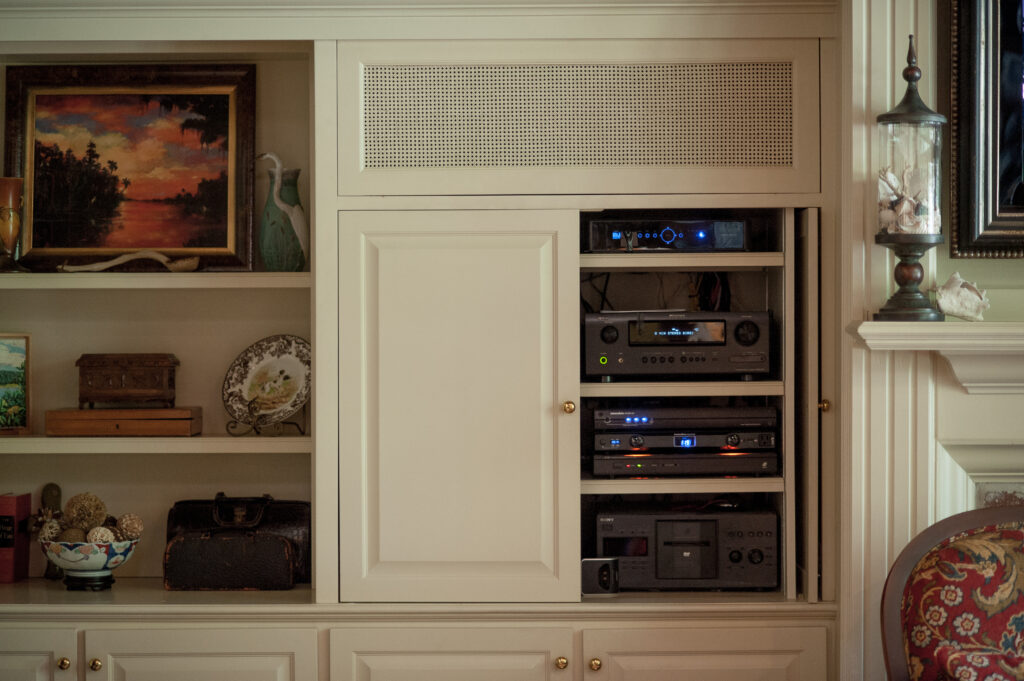Pairing Modern sound with traditional charm
Story by Clint DeBoer • Photography by Tina Sargeant
Living in an historic home is wonderful. It’s one of the delights of downtown living. The architecture has such character, and the build quality — both interior and exterior — simply puts a lot of modern construction methods to shame. With all of that character, the last thing you want to do is slap up one of those newfangled flat-screen TVs and plop a rack full of A/V equipment down on your 1920s’ heart pine floors. It’s just not right, you know? So what are your options? Well, fortunately there are a lot of ways to bring the home theater experience to your living room without having to disrupt the beautiful architecture of your historic living space. Some of these options are even quite affordable. I’ll outline some of my favorites as well some things that might be good to stay away from — like those built-ins originally designed to hold that 32-inch tube TV. If you still have one of those you might want to consider a twenty-first–century upgrade — hang that TV on the wall!

TVS THAT LOOK LIKE FRAMED ARTWORK
There are a couple of companies on the market that make these excellent products that transform your flat-panel television, literally, into a work of art. An actual frame goes around
your TV, and a piece of textured artwork or photography is shown. When it’s time to watch TV, you turn it on and the artwork rolls up, revealing your television screen. It’s a high-dollar product, but it’s really impressive, and the installations I’ve seen look fantastic. These television frames can be ordered in a variety of styles, and most companies will reprint
(when permitted) artwork, so you can customize what you want to see hanging over your mantel when the television is off.
RELOCATE THAT GEAR!
You don’t have to cut back on the amount of equipment you pour into a home with classic architecture; you just have to hide it. In fact, to get the best experience possible, you may find that it takes a lot more equipment to distribute audio and video to the rest of your house. Building a single-room home theater is simple. Building a whole-home A/V system is another thing entirely. With a lot of older homes there may not be a ton of closet space, but finding a nice nook or area that you can dedicate to your gear will allow you to maintain that elegant look you worked so hard for in your living room. In the industry we call this “working the wife-acceptance- factor (WAF).” You can build a really high-quality surround
sound system — you just have to make sure it doesn’t take over the living room.
With many of the older homes having either roomy attics or ample crawl spaces underneath, running wiring to a remote location isn’t typically that big of a deal. Plus, you can hire that local high school kid to get under there and pull the cable. They might even think it’s fun.
After your equipment is relocated, you’ll need to utilize a wireless remote control system. These can be either very simple systems that transmit your standard IR (infrared) remote codes to the stow-away location, or they can be sophisticated RF (radio frequency) or WiFi devices that let you control the entire system with a touch screen or an iPad. My recommendation is on a sophisticated system. They are much more enjoyable to use and, while you’ll pay for the convenience, it’s really a key component of the entire home theater experience itself. We’ve seen touch screen systems that will let you change the temperature in your house, dim the lights, drop a projector screen, and navigate your Blu-ray disc collection in one fell swoop. It’s up to you how far you choose to take it.

IN-CEILING AND IN-WALL SPEAKERS ARE YOUR FRIENDS
Once your equipment is out of the way, the next big hurdle is avoiding large, visible speakers. Now, I love large speakers. I think speakers are furniture. My wife, however, disagrees. And while I get away with a lot in our house, hiding the speakers is going to be preferable. The two ways this can be done is via the use of in-wall speakers or in-ceiling speakers.
As you may guess, these are speakers that are literally installed in the wall cavity or ceiling and which project sound into the room without taking up space. With some of the new paintable speaker grilles, you almost can’t even see them.
I would throw down a couple of rules here, however. One, in-ceiling speakers make great surrounds. They don’t make such great front speakers. The reason for this is that you want your audio to come from the general vicinity of the television, not from above. In-ceiling speakers also have a dramatically limited dynamic range, so they can’t produce all of the midrange that gives clarity to the dialogue in movies and the vocals in music.
In-wall speakers, however, have a lot more to work with. They can be larger and still be unseen. If you can’t do in-wall speakers — perhaps because of a built-in — then I’d recommend trying to get a pair of bookshelf speakers. These can sit on stands, or literally on a bookshelf, should you have one next to your television. The wiring can be hidden in the wall just as easily and will be nearly invisible. You can also find many loudspeaker manufacturers today who will allow you to order custom finishes, so you can even match them to your décor. And if you have one of those old built-ins from the 1980s, well, this is a great time to consider giving it the heave-ho and mounting your flat-panel TV right on the wall for a cleaner look.
SUBWOOFERS ARE MEANT TO BE FELT, NOT SEEN
Subwoofers are my favorite speakers. And let me just clear something up. If you’ve ever heard a “bass module” made popular by that four-letterword company starting with “B” that advertises on late-night TV, you have yet to hear a true subwoofer. A subwoofer can, when used properly, revive you during cardiac arrest. It can displace the air in your lungs and move your sofa backwards several inches during a fight scene. It will ensure the family pet does not interrupt you while you’re watching the Blu-ray of Iron Man 3. Subwoofers are awesome. You need one. And they can be hidden.
A subwoofer, when properly used, is a speaker that carries frequencies so low, you actually can’t tell where they’re coming from. That means you can relocate this boxy-looking speaker underneath a coffee table or tuck it into a corner. You can set a plant on it. A very heavy plant. With grippy tape. The bottom line is that this speaker is what will bring the movie-watching experience to your living room — without the sticky floors and rude people in front of you commenting on everything the lead character does. They can be as big or as small as you like, but the best rule of thumb is to allocate at least a 12-inch sub for a medium-sized room. For the adventurous, two subs are better than one and almost always yield a more consistent (less “peaky”) sound.
PROJECTOR SCREENS CAN BE HIDDEN
If you’re all impressed with your new 60-inch flat-screen television, don’t come to my house. I have a 100-inch projector that brings the movie-watching experience to a new level. But surely you can’t do a projector in an early 1900s’ home? Yes. Yes you can. There are a couple of reasons why front projection is surging in popularity. First, projectors have come way down in price. You can pick up a 1080p projector for under $1,000. That’s likely a lot cheaper than you originally paid for your flat-panel TV (unless you have a model under 50 inches in size). With these new projectors you can achieve images of very high quality up to 120 inches diagonal. A very nice projector will run you $2,000, and of course you can pay as much as you want from there as you get better and better quality and capabilities.
The second reason front projection is taking off is due to the significant price drop for what are referred to as “tensioned” electric screens. There are companies now that are manufacturing these screens for under $500. A tensioned electric screen can descend from the ceiling and has cables to keep the screen nice and tight for movie-watching. This differentiates it from those screens you see in offices and schools which tend to curl on the edges and, in my opinion, look pretty unprofessional.
Hiding a projector screen can be done in a number of ways. If the joists run in your favor, then the screen can be installed in the attic and it can drop down through the ceiling into the room and retract when not needed. With higher-end systems, all of this happens automatically when your Blu-ray player starts up and you begin to watch a movie. Another way to hide the screen is to simply butt it up against the wall, or place it in front of your fireplace and frame around it using crown moulding. You can just about blend it into your ceiling in this manner and it covers up the black or white casing that holds the screen.
 HIRE A PROFESSIONAL. NO, SERIOUSLY, HIRE A PROFESSIONAL
HIRE A PROFESSIONAL. NO, SERIOUSLY, HIRE A PROFESSIONAL
Putting a home theater together may not seem like that much, or it may seem absolutely overwhelming. You’ve really just got speakers, A/V gear, the display, and the control system. But you have to wire everything up, and the “simple” control system might take more time to properly configure than everything else combined. In either case, there’s hope for those of us living in historic homes. We, too, can have the true home theater experience. It just takes a little bit more effort and a lot more thoughtful planning to do it right.
And speaking of doing it right, you really want to hire a professional when it comes to integrating home theater into one of these homes. I’ve seen it done wrong, and the results are a mixture of comical and devastating. The difference depends on whether or not you’re good at laughing at yourself (and whether you can afford to pay to get it fixed). When it all comes down to it, hiring a pro will put someone in change for whom this is “not his first rodeo.” My recommendation backs the use of professional custom A/V installer all the way — an endorsement that is now even more vigorous after helping several of my friends repair the damage they caused trying it on their own.
